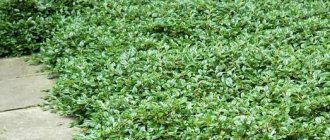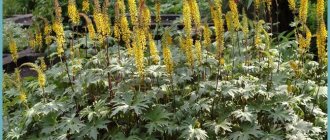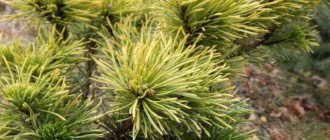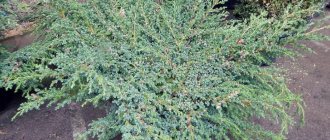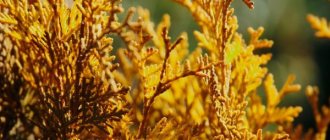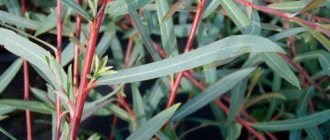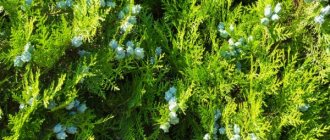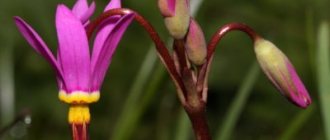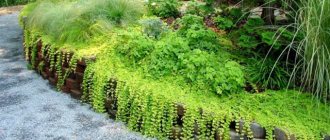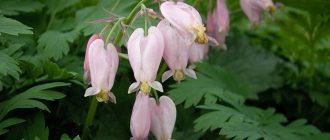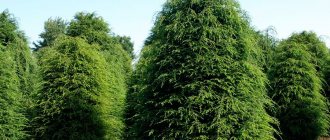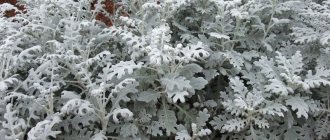When creating a landscape design for a personal plot, every gardener wants to make it unique. Some prefer capricious exotic plants, others choose familiar garden crops, while others try to find flowers that require minimal care. One of these plants is cotoneaster horizontalis. It is unpretentious, frost-resistant and perfect for those who want to create an original composition.
Characteristics and features
Cotoneaster horizontalis is a creeping shrub of the Rosaceae family. This is a fast-growing, evergreen compact shrub, no more than 50 cm in height. Its main characteristics include the following indicators:
- The shoots are pinnately branched and look like a fish tail. They are located with each other in the same plane, “spread out” up to 1.5 meters wide.
- The leaves are dense, small, round in shape, dark green.
- The flowers are inconspicuous, paired or single, bright pink with a red tint.
- The fruits are spherical, bright red, about 5 mm in diameter.
Types and varieties
The genus Cotoneaster includes more than 270 species. The name Cotoneaster classifies plants of a genus belonging to the rich and diverse rose family. These are usually undemanding plants growing on rocky, poor soils. The main types: chokeberry, horizontal, Alauan, brilliant, vesicular and others, described in more detail below.
| Kinds | Photo |
| Black cotoneaster (Сotoneaster melanocarpus) | |
| Cotoneaster alaunicus | |
| Cotoneaster bullatus |
Dammera (Cotoneaster dammeri)
Evergreen shrub, low-growing, creeping, native to China. It grows up to 15 cm in height, forms creeping branches that can take root.
The leaves do not fall off in the winter, are elliptical, entire, spherical, have a dark green color and a shiny texture. Dammera grows wide and has much larger leaves, longer shoots than the horizontal one. Tiny white flowers appear among the long leaves in May, collected in bunches and reaching about 1 cm in diameter.
In winter, spherical coral fruits with a diameter of 8 mm remain on the shoots, beautifully contrasting with the green leaves. The fruits contain several nuts, decorate the cotoneaster until spring, and are a delicacy for birds. When grown in Moscow and the Moscow region, the bush must be covered for the winter, because it is very sensitive to frost.
The Dummer cotoneaster variety is used as:
- ground cover crops under trees;
- covers the surface, effectively replacing the lawn;
- in urban plantings, near roads - resistant to air pollution;
- looks good at higher elevations due to its rapid growth;
- used to strengthen slopes and retaining walls;
- in addition to practical use, it gives an aesthetic effect - dark green leaves and red fruits look interesting against the background of stones and inclined slopes;
- deciduous shrubs decorate terraces and balconies and are grown in pots and boxes.
Long, dense stems can easily choke out other plants and hinder their growth. The shrub prefers semi-dark and sunny positions and develops well in the shade. It is a tolerant species that grows in moderately moist garden soil with a neutral pH. The plant is ground cover, grows quickly, requires a large area - seedlings are planted at a distance of 150 cm.
Dummer's cotoneaster is not demanding on conditions. Basic care procedures include:
- regular removal of damaged shoots;
- pruning in spring to remove dead shoots and prune young shoots, stimulating plant growth.
Coral Beauty
Dwarf shrub grows up to 1 meter in height. Characterized by long, curved and creeping shoots. As a ground cover plant, it will miraculously cover certain areas of the garden, decorating it with dark green foliage. It blooms in late spring and early summer - white flowers appear abundantly among the shiny leaves, decorating the plant, then round red fruits appear. The fruits do not fall off, remaining on the bushes from September to spring. The Coral Beauty variety prefers sunny and semi-shady positions. Grows well in moderately moist garden soil. Planted in garden plots, rock gardens, balcony containers, and terraces.
Dummer's cotoneaster - photo of the Coral Beauty variety
Eichholz
An evergreen shrub grows up to 25 cm in height. It is distinguished by very densely branched shoots, spreading over the entire surface, like a thick carpet. The dark green leaves turn an interesting orange color in the fall. The plant blooms in May–June, producing white flowers. The flowers are replaced by orange or red fruits. The bush prefers fertile soils, semi-shaded and sunny positions.
Photo. Cotoneaster Eicholz
Boer
A beautiful low shrub, the maximum height of the dwarf cotoneaster variety Boer is 50 cm. A characteristic feature is hanging shoots inclined downwards. Decorates gardens, walls, rock gardens. The leaves are dark green, with wavy edges. In autumn the foliage turns red and falls off in winter. In May-June the shrub blooms, forming pink flowers collected in large inflorescences. In August, spherical red fruits with a diameter of about 1 cm appear. The variety prefers sunny places. An important condition for growing cotoneaster is moderate soil moisture. The bush does not require cutting. Caring for cotoneaster involves using light pruning and removing damaged shoots. Suitable for growing in containers, on balconies and terraces.
Photo. Cotoneaster Boer
| Other interesting varieties of Dummer's cotoneaster - photos | |
| Skogholm | |
| Mooncreeper | |
| Major | |
Whole-edged (common) (Cotoneaster integerrimus)
Common cotoneaster is a bush of the rose family, found in Europe and Asia. Thanks to its interesting crown and beautiful flowers, it has become popular as an ornamental plant; today it is found in many garden plots. The bush is highly branched, densely leafed, reaching a height of 1.5 meters, with weakly branching shoots. The leaves are small, ovate, green, slightly wavy at the edges.
Flowering begins at the end of April and continues in May. The flowers of the common cotoneaster are small, pink, collected in small, short inflorescences. Decorative fruits that appear in late summer resemble small apples - red, round or oblong. Undemanding, resistant to frost and drought. It loves rocky positions and is planted in rockeries, near walls, on various types of slopes. Prefers calcareous soils, light, poor, well-permeable and rich in humus, sunny, wind-protected positions.
Photo. Common cotoneaster
Black (Cotoneaster niger)
The species is rare in southern Europe, requires active protection, and loves warm positions.
Photo. Black cotoneaster
Tomentos (Cotoneaster tomentosus)
Looks like an ordinary cotoneaster. The stems are erect, the young shoots are pubescent, the leaves are round, 3-6 cm long. Pink flowers are collected in several pieces (3-12) in a glass, the peduncles are pubescent. The fruit is bright red, spherical, with white pubescence, without gloss. Flowering: May-June. The fruits ripen in October. Loves limestones.
Photo. Felt cotoneaster
Holly (Cotoneaster acutifolius Turcz)
It grows to a height of 3 meters, a width of 2 meters, loves sunny and semi-shaded positions, has low requirements, and is resistant to drought and frost. Ideal for creating hedges. It blooms very profusely with red flowers. The fruit is black and shiny. In autumn, the leaves turn shades of yellow and red.
Photo. Holly cotoneaster
Horizontal (Cotoneaster horizontalis Decne.)
One of the most impressive species with creeping shoots. This is a low-growing shrub, 0.8 meters high, grows strongly to the sides, reaching a width of 2 meters. The leaves are round, small, green, hard, red-orange in autumn, deciduous or semi-evergreen. The leaves are evenly spaced on both sides of the stem.
Photo. Cotoneaster horizontalis Decne
Small, white or pink flowers bloom in May–June. The spherical, small, red fruits remain on the bush in winter. The shrub tolerates all types of garden soils and loves sunny places.
A very ornamental plant, good for:
- rock gardens;
- landscaping walls;
- designing slopes where long shoots will look better;
- as a ground cover plant;
- for lawns in the form of a carpet;
- for house works.
The disadvantage of this species is that it is relatively resistant to frost. In autumn, the bush should be covered with straw or branches of coniferous trees.
Popular variety Robustus - photo
Shiny (Cotoneaster lucidus Schltdl.)
The shiny cotoneaster, unlike the horizontal one, tolerates frost well. The shrub has a very high crown, shoots grow up to 2 meters, so it is ideal for planting in groups or on hedges. It can be found in urban spaces such as parks and tolerates air pollution well. Pride of the bush:
- carmine fruits;
- shiny leaves, turning red in autumn.
Splayed (Cotoneaster divaricatus)
This is one of the most beautiful types of cotoneaster with beautiful autumn leaf color and bears fruit abundantly. Grows up to 2 meters, widely branched. The leaves are dark green, shiny, scarlet in the fall, and fall off in the winter. White and red flowers at the base of the petals bloom in June. Dark red ellipsoidal fruits ripen in August-September and remain on the branches until October. Varieties of the spreading type are used for group plantings, grown on a trellis, in rocky gardens. They tolerate urban conditions well.
Pressed (Cotoneaster adpressus Bois)
Low growing shrub, widely branched, ground cover plant. The small, ovoid leaves turn red and fall off in the winter. The fruits are spherical, bright red. Cotoneaster adpress loves warm and sunny positions. Used on slopes and in rock gardens.
Multifloral (Cotoneaster multiflorus Bunge)
The main decoration of the multi-flowered species is snow-white five-petaled flowers, reminiscent of strawberry flowers. The shrub grows up to 2 meters in height and grows significantly. The leaves are quite large, ovate, golden in autumn. The white flowers are quite large, collected in bunches, and bloom in May. Red fruits ripen in August-September and then fall.
The shrub is suitable for forming hedges - it has a high crown and grows strongly. The multi-flowered appearance, thanks to its high decorative qualities, looks great individually.
Willow leaf (Cotoneaster salicifolius)
Wide shrub up to 3-5 m tall, with vertical, thin, hanging branches. The leaves are evergreen, elliptical - lanceolate, thick, shiny. Flowers with a diameter of 6-7 mm, with white petals. The fruits are 4-5 mm long, spherical, red, glabrous, shiny. The willow cotoneaster blooms and bears fruit very profusely. The fruits remain on the bush for a long time. Cotoneaster varieties of this species can only be grown in warm regions.
Variety of varieties
Horizontal cotoneaster is the most popular and valuable species, long grown in gardens. This plant has several varieties that have their own unique characteristics. The most famous of them:
- Common cotoneaster. This variety is distinguished by the shiny surface of the leaves and the black color of the fruits.
- Multiflowered - a shrub that grows up to 3 meters. Light green leaves change color to crimson in autumn. The flowers are collected in corymbose inflorescences.
- Pressed - a variety with low creeping branches. The height of the bush is about one and a half meters.
- Chokeberry. A special feature of this cotoneaster is its black fruits. The bush blooms for one month, starting from the 5th year of life.
- The red-fruited variety differs little from the black-fruited one. The only difference is the color of the fruit.
- Horizontal shiny is one of the most popular species, up to 2 meters high. The leaves of this plant are green with a shiny, silvery surface.
- Variegatus is an evergreen low shrub with cream-colored leaves.
- Coral extravaganza - characterized by a spreading crown. The leaves are dark green and turn red in autumn. Small flowers with pinkish petals. The fruits ripen in early autumn and have a shiny, smooth surface.
Cotoneaster varieties.
There are several types of frost-resistant cotoneaster, which are most often used in decorating garden plots; they can be used to form hedges or other elements of decorating household areas.
Tall cotoneasters.
- Chokeberry. This variety of cotoneaster is very well adapted to cold climates. The height of the shrub can be up to 2 m, the shoots are reddish-brown, the fruits are black. Flowering and fruiting begin quite late, only 5 years after planting, but fruiting is then annual, and flowering lasts about a month; during ripening, the brown color of the berries changes to black. This variety is suitable for almost any soil and can grow in shade and partial shade. The plant attracts bees.
- Brilliant. The height, like the previous representative of the genus, can reach up to two meters. The peculiarity of this plant lies in its leaves; they are pointed at the ends, and their color changes from green to purple in the fall. Moreover, their surface is always shiny. The inflorescences are pink and last up to a month. From the age of four the bush begins to bear fruit. The fruits are shiny brown and do not fall until the third decade of the autumn season. Propagated by seeds and cuttings. Looks good as a hedge, is frost-resistant and unpretentious to soil conditions.
- Ordinary. This cotoneaster is deciduous and branched, and can also reach a height of 2 m. Its young shoots can be distinguished by their characteristic villi, which subsequently disappear as they mature. The berries of the common cotoneaster are red, and the flowers are white with a pinkish tint. The plant is unpretentious to soil and climatic conditions, can grow in almost any area, and is not afraid of cold weather.
Low-growing cotoneasters.
- Horizontal. This type of cotoneaster received its name due to the peculiarity of its growth; it practically spreads along the ground, not reaching a height of more than 50 cm. This variety is valued for its decorative qualities during the May flowering period. The combination of pink-red flowers with small rounded leaves in a green or purple hue creates a very beautiful appearance. The fruiting period begins in September, the fruits are red with shine, the shape is spherical, they begin to fall only in December, which distinguishes them favorably from their other counterparts.
- Dammera. Representatives of this variety are evergreen and creeping plants. They are long-lived, grow in almost any soil, and are resistant to dry seasons. They can entwine themselves around rocks and grow on slopes and hills. The leaves are small, ovate-shaped. In summer, their color is green, but with the arrival of autumn they acquire a lilac-reddish tint.
The plant also has a low crown, and its height can rarely exceed 40 cm. During the May flowering period, Dummer's cotoneaster produces small flowers with a pleasant aroma, white or pink. The shape of the fruit is spherical, the color is bright red.
Cotoneaster in landscape design
Due to its decorative features, horizontal cotoneaster has been used by gardeners for a long time in landscape design. It is used to create unique compositions. Decorating gardens with such plants first began in China. Today it is widespread throughout the world as a significant element of landscaping in a personal plot, performing the following functions:
- Used to create hedges.
- This plant looks impressive as a tapeworm. It looks great in the center of a stone composition and against the background of a lawn.
- Cotoneaster is suitable for edging stone-lined garden paths and borders.
- In landscape design it is a decoration for alpine slides and rockeries. Can create a magnificent composition in combination with flowering and creeping plants.
- It goes well with various plants: barberry, juniper, quince, thuja and cereals.
Botanical description
Cotoneaster bushes can be deciduous or evergreen depending on the type you grow. For the most part, cotoneaster is a densely branched shrub used for street landscaping. A cotoneaster hedge is a fairly common sight in our cities. The leaves of this plant are small, simple, alternate, ovoid, entire, dark green in summer, and acquire shades of red in autumn. Cotoneaster blooms with small pink or white flowers - single or collected in corymbose or racemose inflorescences.
Small cotoneaster fruits are black or red. For better or worse, cotoneaster grows very slowly and lives in one place for up to fifty years, or even longer. There are about forty species of cotoneaster in cultivation, however, in addition to species plants, various forms and varieties of shrubs are widely used in garden design. Among the most popular species are the brilliant, whole-edged and black-fruited cotoneasters, which have high winter hardiness.
Amateur gardeners love cotoneaster for its ease of care and undemandingness to growing conditions. As for professionals, cotoneaster in landscape design is most often used by them as a hedge.
- Wintergreen: planting and care, properties, types
Preliminary preparation
Before planting cotoneaster, it is necessary to carry out preparatory procedures. The full growth of this culture depends on this. It is important to choose high-quality planting material and a suitable place for planting. When choosing a horizontal cotoneaster seedling, you should consider the following nuances:
- This plant comes in two forms: with pure green foliage and with white-edged foliage. Both forms look great in landscape design. If you purchase seedlings of both types, you can create a magnificent landscape design.
- It is better to purchase planting material from nurseries and specialized retail outlets.
- Before purchasing, you must carefully inspect the seedling. There should be no signs of pests or diseases on its shoots and leaves. The container should be filled with moist, clean soil.
- You should not buy cotoneaster from hand, especially if you do not know what it really looks like.
When choosing a place to plant cotoneaster, you should give preference to well-lit places. The plant also does well in light partial shade. However, in this case the foliage will have a less saturated shade. It is better if the cotoneaster is planted on a small hill. This will help avoid stagnation of moisture at the roots.
This plant requires nutritious fertile soil. The soil should consist of peat, sand and turf soil. The area should first be well dug up and leveled.
Landing rules
The time for planting horizontal cotoneaster depends on the selected seedling. If it has a closed root system, it can be planted any time from spring to August. A seedling with bare roots can be planted in open ground in April - May or in September - October.
For planting, prepare holes of a size corresponding to the root system of the seedling. Considering that the crown of cotoneaster grows greatly, a distance of about two meters should be left between seedlings.
At the bottom of the hole, make a drainage layer using broken brick, crushed stone or gravel in a layer of 10-20 cm. Then pour in a little soil mixture.
The sprout with a closed root system is carefully removed from the container and placed in the planting hole without shaking off the soil from the roots. If the roots are open, the seedling can be lowered directly onto the drainage layer.
Next, the plant is covered so that the root collar is flush with the surface, and the soil is well watered.
Planting and care
The plant will develop well in illuminated areas, as well as in partial shade on fertile soils. The best time for planting is early spring, when the first buds appear on the branches. If this is done later, the young seedling may not take root.
Despite the fact that horizontal cotoneaster is considered unpretentious in care, the soil for its development is of great importance. It is advisable to add a specially prepared mixture of the following components before planting:
- 2 parts sand;
- 1 part peat compost;
- 2 parts of turf.
All this is mixed and added to the prepared well. It is also recommended to add lime at the rate of 300 g per 1 m2 of land. Such a substrate will contribute to 100% plant survival. The soil must be well-permeable so that moisture does not remain in it after watering. Otherwise, the bush will grow poorly and may soon die. The hole for planting must be made taking into account the size of the crown of the bush.
Bushes are planted at intervals of at least 0.5 meters from each other. The holes are made about 60 cm deep so that the root collar is level with the ground surface. It is advisable to lay a layer of drainage at the bottom of the hole so that the plant can take root better and grow in the future. Usually, broken brick or gravel is used for this, which is poured in a layer of 15 cm before planting.
Features of cultivation
Caring for cotoneaster is quite simple and can be done by novice gardeners. However, for successful cultivation you need to have some knowledge.
Horizontal cotoneaster does not like excessive moisture. Even in dry heat, it should not be watered frequently. The plant only needs watering once a month in normal times of the year, but in the hot summer it is watered once every 2 weeks. For an adult shrub, 3 buckets of water per watering will be enough. When the moisture is absorbed, the soil around it is loosened at the base of the bush to a depth of 15 cm, removing weeds.
In spring it is necessary to apply fertilizers . Usually this procedure is performed in early spring with the first sunny days. A special solution is used, prepared from several components: 10 liters of water and 25 g of urea. They dilute everything and pour the resulting solution under the root of the bush.
It is recommended to do the next feeding at the end of May before flowering begins. As a fertilizer, you can take the following composition: 1.5 g of potassium sulfur per 1 m2 or superphosphate in the amount of 60 g per 1 m2. In the fall, it is also advisable to feed the plant with potassium-phosphorus fertilizer. If the bush develops poorly, you can use slurry in a ratio of 1:10 or diluted bird droppings in a ratio of 1:15.
Pruning cotoneaster
Shrubs tolerate pruning well. It is necessary to perform several types of haircuts during the season:
- rejuvenating;
- sanitary;
- formative.
The last of them is aesthetic and is best done in early spring before the first buds appear. Since the plant grows rapidly, it is advisable to prune it on time. Experienced gardeners give shrubs various shapes, decorating the landscape design of their site.
According to the rules of pruning, you need to remove dry and diseased branches. Also pruned are those that grow in the wrong direction. Young shoots are cut by 1/3 after they have grown for a year. Next year, after planting, the branch is cut by ¼ to form a beautiful crown.
The shrub should be prepared for winter so that it survives the frost successfully. It is recommended to cover it with peat or dry leaves. It is advisable to bend the branches to the ground to protect them from severe frosts.
Reproduction methods
There are several ways to plant horizontal cotoneaster, which are used by gardeners in their plots:
- seeds;
- layering;
- vaccination;
- cuttings.
All these methods make it possible to plant a plant, but only one of them is highly effective - cuttings. For this purpose, young cuttings are used to plant them in open ground. Planting material is selected in early June from young shoots.
Selected cuttings are soaked for 1 day in water. They can also be soaked in a special solution for good rooting. Planting material is planted in loosened soil at an angle of 45°. It is recommended for planting to use a substrate prepared from a mixture of sand and peat in equal proportions.
The planted cuttings are covered with cut plastic bottles with open necks. Only next spring will they be ready to be transplanted to a permanent location.
Planting by layering is used in the spring. The tops of young shoots are buried in the soil to a depth of 10-15 cm. They are placed in prepared holes with a substrate of sand and peat. Only after a year can they be planted as a young bush.
If you sow cotoneaster with seeds, this method rarely gives an effective result. The plant does not have good germination. Planting material is selected from fruits that can be collected in October.
Reproduction by grafting is suitable only for experienced flora lovers. It is the most complex and requires a lot of time to care for the grafted part.
Use in landscape design
Gardeners often use horizontal cotoneaster to decorate their plots. The small bush pleases the eye with miniature glossy leaves, flowers and bright fruits. They look beautiful not only in autumn, but also in winter against the background of snow, since they hang until spring.
This plant is an excellent option for creating hedges, border structures and planting on an alpine hill. With the help of pruning, various shapes are created, which gives the bushes decorative properties.
The evergreen shrub looks great against the backdrop of coniferous plants. It is often planted in group compositions. It also looks good in single plantings, decorating the garden at any time of the year.
Plant care
Just like planting a horizontal cotoneaster, caring for it will not cause much trouble. The main thing is to follow some rules, taking into account the characteristic characteristics of the plant.
- Watering . Cotoneaster is a drought-resistant plant. It needs to be watered once or twice a month. In conditions of prolonged heat, you can increase watering. No more than 7 buckets of water can be added to one adult bush.
- Mulching and loosening . After watering around the cotoneaster, it is necessary to remove the weeds and loosen the soil to a depth of about 15 cm.
- Feeding . If a seedling of this plant is planted in nutritious soil, it can cope without fertilizing, except for the obligatory spring feeding. In the spring, after the soil has warmed up, it is necessary to apply the first fertilizing - a urea solution. The second time the cotoneaster is fertilized with superphosphate before flowering in April - May.
- Pruning of horizontal cotoneaster must be carried out regularly, as it grows very quickly. The first time this is done before the sap begins to flow in early spring. Remove all broken, dry and damaged branches and shoots that protrude greatly from the overall shape of the crown.
- Shelter for the winter . Despite the fact that the horizontal cotoneaster is frost-resistant, in cold climates it should be covered for the winter. The shoots must be carefully rolled toward the center, and the soil around the bush must be mulched. Then cover the plant with spruce branches or fallen leaves.
Aftercare
Caring for cotoneaster is very easy. It is because of this characteristic that it is often called “a plant for the lazy.” However, to ensure decorativeness throughout the entire life cycle, standard cultivation practices should be followed. These include irrigation, fertilization, loosening, as well as integrated plant protection.
Watering
Cotoneaster has a powerful root system, which, after full development, is capable of independently extracting moisture even from a meter-thick layer. However, before rooting, the plants are systematically moistened. The reference point is the drying of the surface layer. Adult specimens are irrigated only during periods of severe drought. Cotoneaster responds well to sprinkling, which allows you to wash away dust from the shoots, making it easier for the flora to breathe.
Reproduction methods
It is not difficult to grow horizontal cotoneaster yourself. Even the most inexperienced gardeners can do this. Reproduction of the plant is possible in several ways: cuttings, seeds, layering and dividing the bush. Each option has its own characteristics that must be taken into account.
Seeds and cuttings
Propagation by seeds is used very rarely, more often for industrial cultivation, because the seeds of cotoneaster horizontal variegatus germinate poorly. Sprouts produce only 60% of the seeds.
After waiting for the fruits to fully ripen, somewhere in mid-October, they are picked, peeled and the seeds are removed, which are placed in water to select healthy and high-quality ones. Good seeds sink to the bottom. Any that float up will not be of any use, so they should be thrown away.
To increase the number of seedlings, the seeds must be stratified. Mix dry seeds with peat and sand, moisten them a little and place them in the cold (t - 0° C) until spring.
When the soil warms up in the spring, the seeds are planted in open ground. Since the germination rate of seeds is not very high, it is better to take them with a reserve.
Propagation by cuttings is more effective and therefore more common. However, this method is not suitable for all types of cotoneaster, since the cuttings do not get along well.
Propagation material is harvested from May to July. To do this, choose strong young shoots on an adult bush. Cuttings of these are 15 cm long. Only the top two leaves are left on the cutting, cutting them off a little, the rest are removed and placed in a container with a growth stimulator for a day.
It is necessary to root cotoneaster cuttings in previously loosened soil consisting of peat and sand. They are placed at an angle of 45 °C. Water generously. Cover the top with a cut plastic bottle. Plantings are periodically ventilated, removing the cover to prevent the death of cuttings.
In a month the first roots will appear. When the leaves appear, the cover is removed. Planting material for the winter is well covered with foliage and spruce branches. Young plants are planted in a permanent place next spring, when the cuttings have enough root shoots.
Bush division and horizontal layering
Reproduction by dividing the bush guarantees 100% results. Division is carried out in spring or autumn. Overgrown mature bushes must be divided periodically, as they become shapeless. Using a sharp shovel, the bush is removed and its rhizome is divided into parts, which are immediately planted in prepared soil and watered well.
Another simple vegetative method of plant propagation is horizontal layering. When the soil warms up in the spring, you should select healthy, strong shoots from the bush. Dig grooves under them and fill them with peat and sand. Bend the selected branches to the grooves and secure them with wire. Sprinkle the prepared soil mixture on top. Only the tops of the shoots should remain on the surface.
Such layerings do not require any special additional care. Occasionally they need to be watered along with the main bush. The cuttings can be separated from the mother bush in early spring by cutting the shoot and planting it in a permanent place.
Ornamental plants create coziness, add uniqueness to the garden and are an excellent option for landscaping the area. Horizontal cotoneaster is an unpretentious plant to plant and care for, which is ideal for creating a garden composition.
Photo of cotoneaster horizontal
Ornamental plants are the best option for landscaping an area and creating a beautiful garden composition. Horizontal cotoneaster is ideal for this purpose, being considered an unpretentious plant to plant and care for.
